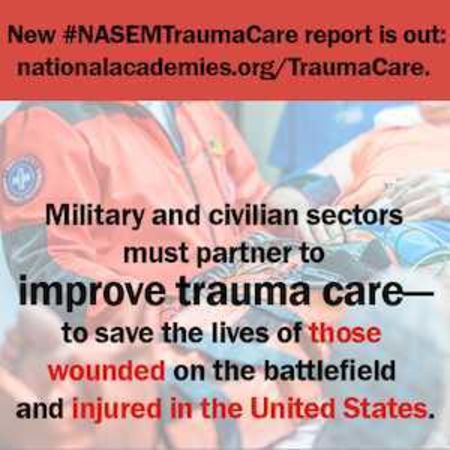Zero preventable deaths after injury can be achieved if trauma care is better coordinated and lessons learned in military healthcare applied to the civilian population, according to a report from the United States National Academies of Sciences, Engineering, and Medicine.
Trauma is the leading cause of death in the United States for those under 46, with an estimated annual cost of around $670 billion in healthcare expenses and lost productivity. Around 20 percent of deaths due to trauma may be preventable with the best trauma care, according to the committee that compiled the report.
Donald Berwick, president emeritus and senior fellow, Institute for Healthcare Improvement, who chaired the committee, said that the military and civilian healthcare sectors have made impressive progress and important innovations in trauma care. “There are serious limitations in the diffusion of those gains from location to location”, he noted.
“Even as the successes have saved many lives, the disparities have cost many lives. With the decrease in combat and the need to maintain readiness for trauma care between wars, a window of opportunity now exists to integrate military and civilian trauma systems and view them not separately, but as one,” he added.
They outline their vision of a unified national strategy and joint military–civilian approach for improving trauma care and a national learning trauma care system.
Such a national trauma care system would the spectrum of trauma care - from preshospital to hospitalisation, rehabilitation and afterwards. Synergy between military and civilian sectors, strong leadership and a strategy to reduce care and outcome variation and support continual learning and innovation.
The current lack of a national authority on trauma care has led to less than optimal outcomes, outcomes that are very variable between trauma centres and funding for research that does not match the level of trauma deaths, the committee writes.
Recommendations
National Leadership
The committee states that only the White House has the necessary capability to catalyse the process of collaboration and coordination necessary to improve trauma care. They also recommend coordination with federal departments responsible for civilian and military healthcare.
Integration
The committee recommends integration of military and civilian trauma centres both to maintain military capability and share knowledge and practice. Military hospitals should care for military and civilian patients.
Data Collection
A national trauma care system should collect real-time data on trauma care across the spectrum to enable knowledge sharing and quality improvement.
Importance of prehospital care
Most lives can be saved in the prehospital phase, and requires integrating prehospital care into the trauma care system. They outline how disjointed emergency medical services (EMS) are currently. EMS receive a fee for transport rather than as a healthcare provider that performs life-saving interventions and care en route to a trauma centre. This should be addressed by Congress, they say.
The study was sponsored by the American College of Emergency Physicians, American College of Surgeons, National Association of EMS Physicians, National Association of Emergency Medical Technicians, Trauma Center Association of America, U.S. Department of Defense, U.S. Department of Homeland Security, and U.S. Department of Transportation. The National Academies of Sciences, Engineering, and Medicine are private, nonprofit institutions that provide independent, objective analysis and advice to the nation to solve complex problems and inform public policy decisions related to science, technology, and medicine.
Responding to Active Shooter and Bombing Events
The National Academy of Medicine, USA published a discussion paper about the health and medical response to active shooter and bombing events on 17 June.
In the paper the National Academies of Sciences, Engineering, and Medicine’s Forum on Medical and Public Health Preparedness for Catastrophic Disasters look at issues involved in response to terrorist incidents as well as possible best practices.
The authors emphasise that their intention is to point to key issues rather than a comprehensive review. “This paper should serve as a prompt for responders and planners to consider areas where their community could address potential gaps”, they write.
The paper’s sections include:
- Countering violent extremism
- Preparing for events of mass violence
- Event Response—EMS Dispatch and Incident Communications; Initial Actions; Secondary Tactical Considerations; Hospital Actions and Prioritisation of Activities; and
- Community Recovery.
“Focus on early access and evacuation of victims to appropriate hospitals, with an early focus on concepts of care borrowed from military models, offer an opportunity to save time and lives, but this must be conducted in accord with interdisciplinary training models and in concert with strong law enforcement incident command. EMS and hospitals should be well resourced and well trained for mass violence attacks and be able to distribute and care for casualties with penetrating and blast trauma. The recovery from these events is difficult and protracted, but a systematic process of support and rebuilding can facilitate community and individual healing.”
The paper’s authors are John L. Hick, Hennepin County Medical Center; Dan Hanfling, UPMC Center for Health Security; Bruce Evans, Upper Pine River Fire Protection District; Sheldon Greenberg, Johns Hopkins University; Roy Alson, Wake Forest University; Suzet McKinney, Illinois Medical District Commission; and Matthew Minson, Texas A&M University.
Image and video credit: National Academies
Note: Video added 10/11/2016
References:
National Academies of Sciences, Engineering, and Medicine (2016) A
national trauma care system: Integrating military and civilian trauma
systems to achieve zero preventable deaths after injury. Washington, DC:
The National Academies Press. Available from nationalacademies.org/TraumaCare
Hick, JL, Hanfling D, Evans B, Greenberg S, Alson R, McKinney S, Minson M (2016) Health and medical response to active shooter and bombing events. Discussion Paper, National Academy of Medicine, Washington, DC. Available from: https://nam.edu/wp-content/uploads/2016/06/Health-and-Medical-Response-to-Active-Shooter-and-Bombing-Events.pdf
Hick, JL, Hanfling D, Evans B, Greenberg S, Alson R, McKinney S, Minson M (2016) Health and medical response to active shooter and bombing events. Discussion Paper, National Academy of Medicine, Washington, DC. Available from: https://nam.edu/wp-content/uploads/2016/06/Health-and-Medical-Response-to-Active-Shooter-and-Bombing-Events.pdf
Latest Articles
Zero Preventable Deaths After Injury
Zero Preventable Deaths After Injury























